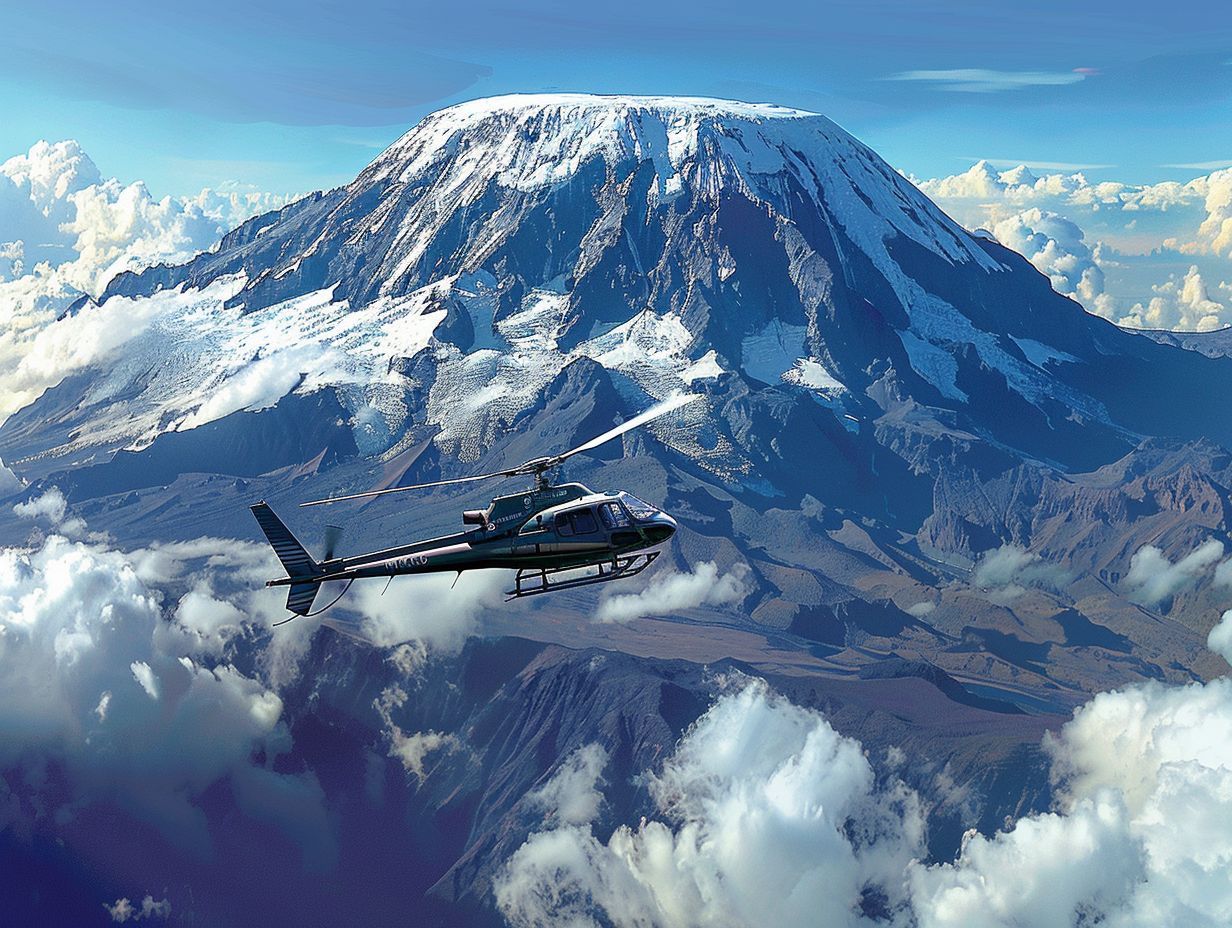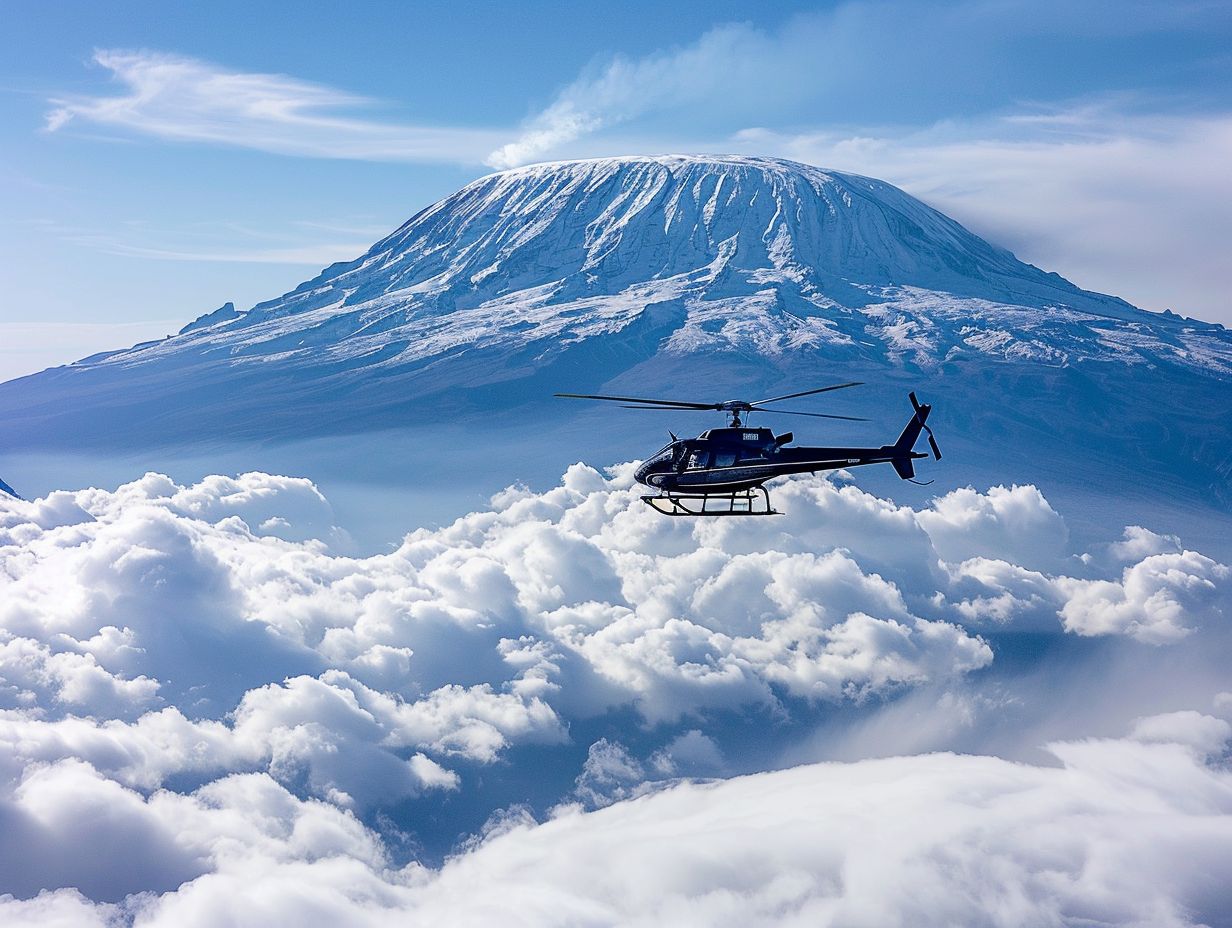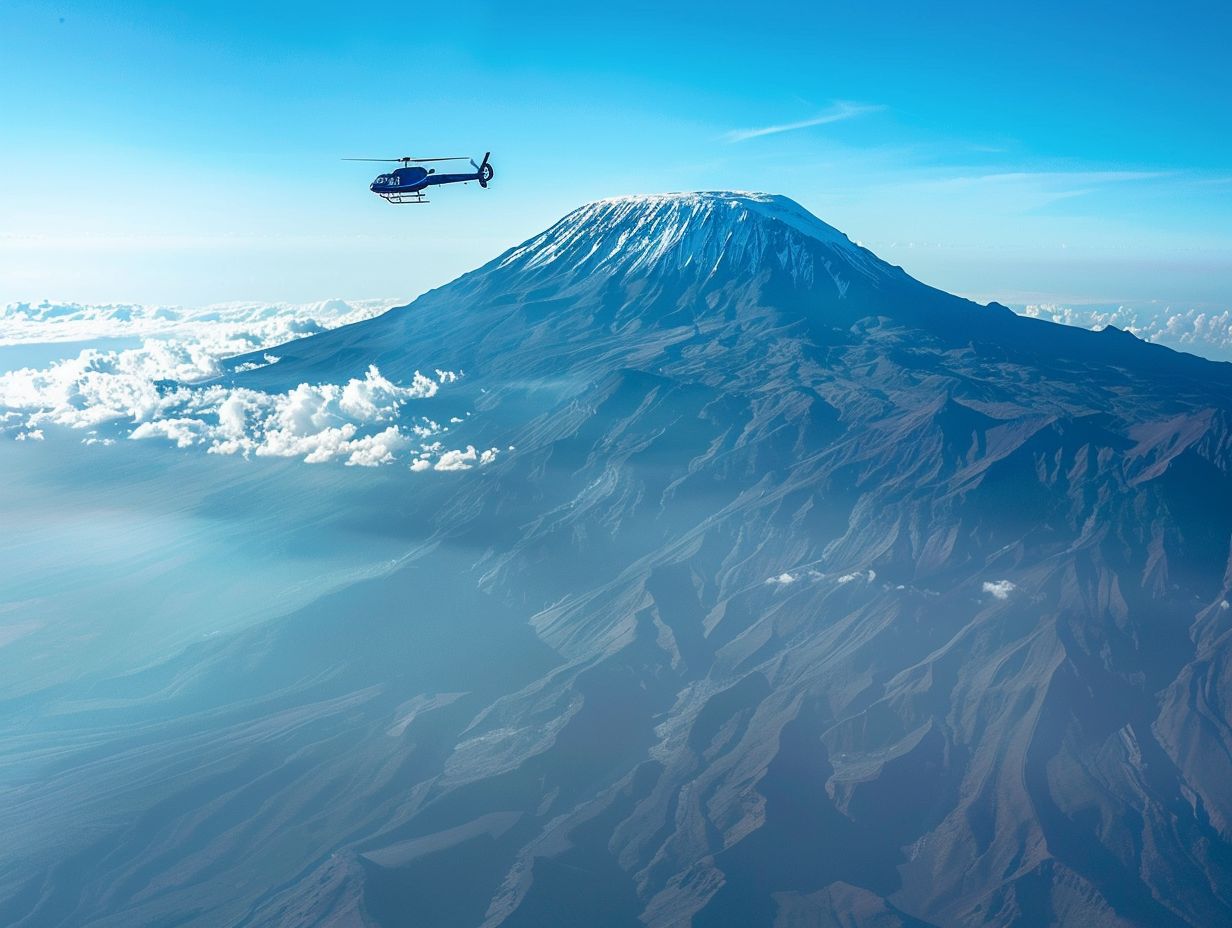
Kilimanjaro Helicopter Rescue
Kilimanjaro Helicopter Rescue is a vital service for adventurers on the iconic mountain who find themselves in need of urgent medical assistance.
We will explore the common reasons why someone may require a helicopter rescue on Kilimanjaro, how the process works, the associated costs and risks, as well as tips on how to prepare for and potentially avoid needing a rescue.
Stay tuned to learn everything you need to know about Kilimanjaro helicopter rescues.
Key Takeaways:

- Kilimanjaro helicopter rescue is a service that provides emergency evacuation for climbers who are unable to descend the mountain on their own.
- Factors such as altitude sickness, physical injuries, and exhaustion are common reasons for needing a helicopter rescue on Kilimanjaro.
- It is important to be prepared and take necessary precautions to prevent the need for a helicopter rescue on Kilimanjaro, as it can be expensive and risky.
What Is Kilimanjaro Helicopter Rescue?
Kilimanjaro Helicopter Rescue is an emergency service provided on Mount Kilimanjaro in Tanzania to evacuate climbers facing altitude-related illnesses or other life-threatening situations using helicopters.
This service plays a crucial role in saving lives as it provides rapid evacuation for climbers in distress at high altitudes where immediate medical attention is vital. Helicopters equipped with specialized equipment and trained personnel navigate the challenging terrain and swiftly reach stranded individuals. Utilizing advanced technology and communication systems, the rescue team coordinates with ground support to locate and extract climbers efficiently.
Why Would Someone Need a Helicopter Rescue on Kilimanjaro?
A helicopter rescue on Kilimanjaro becomes necessary when climbers face severe altitude sickness, medical emergencies, or life-threatening situations that require immediate evacuation to lower altitudes for treatment.
Altitude sickness, also known as acute mountain sickness, is a common danger for climbers attempting the challenging ascent of Mount Kilimanjaro. Symptoms such as headaches, nausea, and fatigue can escalate rapidly, leading to potentially fatal conditions like high altitude pulmonary edema (HAPE) or high altitude cerebral edema (HACE). In these critical cases, prompt evacuation via helicopter is crucial to prevent further deterioration.
Unpredictable weather conditions on the mountain can exacerbate emergencies. Sudden snowstorms, extreme cold, or avalanches can leave climbers stranded or injured, necessitating immediate rescue operations. In such precarious situations, helicopters equipped for high-altitude operations play a vital role in swiftly transporting individuals to safety.
What Are the Most Common Reasons for Helicopter Rescues on Kilimanjaro?
Among the most common reasons for helicopter rescues on Kilimanjaro are severe altitude sickness, medical emergencies, injuries, and conditions that prevent climbers from descending safely on their own.
Altitude-related illnesses are a significant precipitator of such rescues, with the thin air at high elevations increasing the risk of ailments like High Altitude Pulmonary Edema and Cerebral Edema. These conditions can quickly become life-threatening if not addressed promptly.
Emergency situations such as sudden snowstorms or rockfalls also necessitate immediate aerial evacuation, showcasing the unpredictable nature of the mountain environment. Climbers face numerous challenges while descending, including navigating treacherous terrains like the Western Breach route or the steep Barranco Wall, where falls or injuries can occur, creating a need for swift rescue operations.
How Does a Helicopter Rescue Work on Kilimanjaro?
A helicopter rescue on Kilimanjaro involves swift coordination between rescue teams, helicopter pilots, and medical staff to airlift climbers in distress from high altitudes to designated medical facilities for urgent treatment.
Once the distress call is received, the rescue teams quickly mobilize to reach the affected climber’s location. Helicopter pilots play a crucial role in navigating the challenging terrain and weather conditions of the mountain, ensuring a safe evacuation process. Medical staff on board are equipped to provide immediate emergency medical assistance to stabilize patients during the flight.
Constant communication between all parties involved is maintained to coordinate the operation effectively and address any unforeseen obstacles that may arise en route to the medical facility.
-
What Are the Steps Involved in a Helicopter Rescue on Kilimanjaro?

The steps of a helicopter rescue on Kilimanjaro typically include assessing the situation, dispatching the rescue team, preparing the patient for evacuation, coordinating with helicopter staff, and airlifting the climber to a medical facility.
During the assessment phase, rescue staff evaluate the climber’s condition and the surrounding terrain to determine the best approach for the rescue operation. They consider factors such as weather conditions, obstacles in the area, and the urgency of the situation.
Once the assessment is complete, the rescue team is dispatched with the necessary equipment and supplies. The team works together seamlessly, with each member understanding their specific role in the operation.
Preparing the patient for evacuation involves stabilizing their condition, securing them for transport, and ensuring they are comfortable and safe during the helicopter journey.
Coordinating with the helicopter crew is crucial to ensure a smooth and efficient evacuation process. Communication between the rescue staff and the helicopter team is essential for a successful outcome.
The final step involves airlifting the climber to a medical facility where they can receive the necessary treatment. The helicopter crew works swiftly and skillfully to transport the patient to a care center, where medical personnel are ready to provide further assistance.
What Are the Costs of a Helicopter Rescue on Kilimanjaro?
The costs of a helicopter rescue on Kilimanjaro vary depending on the distance, duration, medical services provided, and whether climbers have insurance coverage that includes emergency evacuations.
Helicopter rescues in mountainous regions present unique challenges due to terrain, weather conditions, and altitude. Costs can range from $15,000 to $40,000 per rescue, making it a significant financial consideration for climbers. Factors like fuel, crew, equipment maintenance, and operational logistics all contribute to the total expense.
Having suitable insurance coverage is crucial, as it can offset substantial costs associated with such rescues. Inadequate coverage may result in climbers needing to self-fund the rescue, which could lead to financial strain and uncertainty. Climbers must assess their insurance policies carefully before embarking on such expeditions.
-
What Factors Affect the Cost of a Helicopter Rescue on Kilimanjaro?
The cost of a helicopter rescue on Kilimanjaro is influenced by factors such as the severity of the medical condition, the altitude of the rescue location, the availability of medical supplies onboard, and the insurance coverage or policies of the climbers.
Medical needs are a significant determinant in the pricing structure. For instance, a rescue involving severe altitude sickness requiring immediate medical attention may incur higher costs due to the complexity of the situation and the need for specialized care. Climbing conditions play a crucial role – a rescue during adverse weather conditions or in remote areas with limited access can be more challenging and expensive.
The insurance provisions of climbers can impact the cost variation. Climbers with comprehensive insurance coverage that includes emergency evacuation are likely to bear lower expenses compared to those without adequate insurance. Rescue policies, such as whether the climb organizer has pre-negotiated rates with rescue services, also influence the final cost. For example, climbers on organized expeditions may benefit from group rates which lower individual costs.
What Are the Risks Involved in a Helicopter Rescue on Kilimanjaro?
Helicopter rescues on Kilimanjaro pose risks such as adverse weather conditions, high-altitude flight challenges, potential mechanical failures, and the need for precise navigation in remote mountain terrain.
These challenges demand specialized training and expertise for helicopter crews venturing into the unpredictable environment of Kilimanjaro. From sudden weather changes to limited landing spots at high altitudes, each rescue mission requires meticulous planning and execution. Rescue experts emphasize the critical importance of communication between ground teams and pilot, as split-second decisions can make a difference between success and disaster.
The extreme conditions on Kilimanjaro add complexity to rescue operations, including the risk of altitude sickness among both climbers and rescue personnel. Helicopters must navigate thin air and turbulent winds, all while transporting individuals in need of immediate medical attention. Safety protocols dictate the use of advanced equipment, regular maintenance checks, and continuous training to mitigate potential hazards and ensure the success of each mission.
What Are the Potential Dangers of a Helicopter Rescue on Kilimanjaro?
The potential dangers of a helicopter rescue on Kilimanjaro include oxygen depletion at high altitudes, the risk of hypoxia, the need for specialized equipment like Gamow bags, and the importance of ensuring crew and passenger safety during challenging landings.
At high altitudes, the air is thin, making it challenging to acquire adequate oxygen levels, which poses a serious risk of hypoxia for both rescuers and climbers. This lack of oxygen can lead to dizziness, confusion, and impaired judgment, making rescue operations more difficult.
Specialized equipment such as Gamow bags is crucial in providing a high-pressure environment to stabilize and treat altitude sickness. Safety protocols are meticulously followed to ensure proper utilization of these tools, safeguarding the well-being of all individuals involved in the intricate rescue process.
How Can You Prepare for a Helicopter Rescue on Kilimanjaro?

Preparing for a helicopter rescue on Kilimanjaro involves carrying essential medical supplies, understanding emergency evacuation procedures, having communication devices, and being aware of altitude-related risks to facilitate a swift and safe rescue operation.
Medical kits are crucial and should include items like bandages, pain relievers, and altitude sickness medication. Understanding the emergency protocols ensures timely response in critical situations.
Communication tools such as satellite phones or radios are essential in remote areas. Being knowledgeable about the high-altitude challenges like acclimatization helps prevent altitude sickness. It’s recommended to inform your trekking guide about any medical conditions beforehand for better assistance.
What Are the Necessary Precautions to Take Before Attempting a Helicopter Rescue on Kilimanjaro?
Before considering a helicopter rescue on Kilimanjaro, climbers should inform relevant Search and Rescue (SAR) services, have emergency contacts readily available, acquire climbing permits, and familiarize themselves with the local rescue protocols and service providers.
Communication plays a vital role in ensuring a successful helicopter rescue operation. Climbers need to establish clear channels of communication with SAR services to provide accurate details of their location, situation, and any injuries.
This enables SAR teams to plan and execute the rescue effectively. Climbers must comply with legal requirements, ensuring that they have all necessary permits for aerial assistance. Cooperation and coordination with SAR services are crucial to avoid delays and streamline the rescue process. Service providers, equipped with specialized training and expertise, play a key role in executing safe and efficient helicopter rescues, adhering to established rescue guidelines.
What Are the Alternatives to a Helicopter Rescue on Kilimanjaro?
Alternatives to helicopter rescues on Kilimanjaro include self-descending to lower altitudes, seeking assistance from mountain guides, using portable stretchers for evacuations, and employing first aid measures to manage medical conditions until professional help arrives.
Self-evacuation involves climbers descending independently to lower elevations where potential altitude-related issues may be less severe. This method requires individuals to recognize their physical limitations and make a conscious decision to descend safely.
Seeking help from experienced mountain guides can provide invaluable support and guidance in navigating challenging terrains and ensuring a secure descent. Portable stretchers offer a means of transporting injured climbers across rugged terrain, enabling a smoother and faster evacuation process.
Basic first aid knowledge is crucial in addressing common mountain ailments such as altitude sickness, frostbite, and dehydration, allowing climbers to stabilize conditions before definitive medical care is accessible.
What Are Some Other Options for Assistance on Kilimanjaro?
Along with helicopter rescues, climbers on Kilimanjaro can seek assistance from experienced mountain guides, receive medical aid from trained staff at base camps, utilize oxygen support for altitude-related symptoms, and access emergency evacuation services coordinated by local providers.
Mountain guides on Kilimanjaro play a crucial role in ensuring the safety and success of climbers. They are well-versed in the terrain, weather conditions, and potential risks, offering valuable guidance throughout the ascent. These guides not only lead the way but also provide essential support, encouragement, and expertise that can make a significant difference in navigating the challenges of the mountain.
Base camps on Kilimanjaro are equipped with medical facilities staffed by trained professionals. These facilities can provide initial treatment for common altitude sickness symptoms, minor injuries, and health concerns that climbers may encounter during their journey. Having access to medical support at base camps offers reassurance and essential care in case of emergencies.
What Are Some Tips for Avoiding a Helicopter Rescue on Kilimanjaro?
To prevent the need for a helicopter rescue on Kilimanjaro, climbers should prioritize acclimatization, maintain proper hydration, adhere to gradual ascent plans, recognize early signs of altitude sickness, and follow safety guidelines provided by experienced guides.
Acclimatization is key to allow your body to adapt to higher altitudes gradually. Make sure to plan for rest days in your itinerary for proper acclimatization. Remember, slow ascent is crucial for reducing the risk of altitude-related issues.
Hydration plays a vital role in combating altitude sickness; aim to drink at least 3-4 liters of water daily. Expert climbers emphasize the importance of recognizing symptoms such as headaches and nausea early on to prevent complications. Following safety protocols ensures a secure climb and adds an extra layer of protection. Experienced guides often share invaluable insights and strategies, so heed their advice diligently to enhance your safety on the mountain.
What Are Some Precautions and Strategies to Prevent Needing a Helicopter Rescue on Kilimanjaro?

Preventing the necessity for a helicopter rescue on Kilimanjaro involves thorough planning, staying informed about rescue procedures, hiring experienced guides, carrying essential medical supplies, and coordinating with local Search and Rescue (SAR) services for emergency contingencies.
One key aspect of reducing the chances of requiring a helicopter rescue on Kilimanjaro is investing time in proper preparation before the trek. This includes ensuring you have the appropriate gear for the climb, such as sturdy boots, warm clothing, and high-altitude equipment. Individuals should train physically beforehand to enhance their endurance and stamina for the challenging terrain.
When selecting guides, opt for those with extensive experience on Kilimanjaro and a strong knowledge of the routes and safety protocols. Good communication with the guide is crucial, as they can provide valuable insights and support throughout the journey. Carrying a well-stocked medical kit with essentials like altitude sickness medication, bandages, and pain relievers is critical in case of emergencies.
Frequently Asked Questions:
1. What is Kilimanjaro Helicopter Rescue?
A: Kilimanjaro Helicopter Rescue is a service that provides emergency medical and evacuation assistance for hikers and climbers on Mount Kilimanjaro in Tanzania.
2. Who can use Kilimanjaro Helicopter Rescue?
A: Anyone who is hiking or climbing on Mount Kilimanjaro can use the Kilimanjaro Helicopter Rescue service.
3. How does Kilimanjaro Helicopter Rescue work?
A: If a hiker or climber on Mount Kilimanjaro requires emergency medical assistance or evacuation, they can call the emergency number provided by Kilimanjaro Helicopter Rescue. A helicopter will then be dispatched to their location to provide assistance.
4. What types of emergencies does Kilimanjaro Helicopter Rescue cover?
A: Kilimanjaro Helicopter Rescue covers a wide range of emergencies, including altitude sickness, injuries, and other medical emergencies that may arise while hiking or climbing on Mount Kilimanjaro.
5. Is Kilimanjaro Helicopter Rescue available 24/7?
A: Yes, Kilimanjaro Helicopter Rescue is available 24 hours a day, 7 days a week to provide emergency assistance to hikers and climbers on Mount Kilimanjaro.
6. How much does Kilimanjaro Helicopter Rescue cost?
A: The cost of using Kilimanjaro Helicopter Rescue varies depending on the type of assistance needed and the location of the hiker or climber on Mount Kilimanjaro. It is recommended to have travel insurance that covers emergency medical and evacuation services.